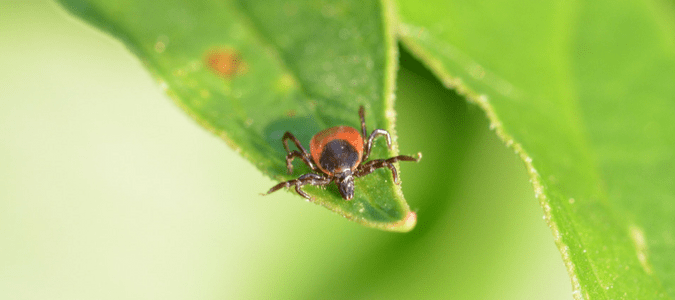
After a hike with your family and dog, you give Fido a belly rub and find a small, dark brown colored bug in his fur. You know that ticks are commonly found in tall grassy areas like the one you just visited, but you also know that it’s flea season. So, what are the differences between ticks and fleas, and how can you tell which one you have seen?
For starters, you should know that ticks aren’t technically bugs at all but rather small arachnids, and while they can vary in size, once they have fed, they generally swell to a quarter-inch long and are clearly visible. On the other hand, fleas are considered true insects and are much smaller than ticks, rarely exceeding an eighth of an inch in size.
Let’s delve a bit deeper into what these pests look like and their behavior so you know more about each creature and the impact they can have on you, your family and your pets.
Identifying Ticks
As you can see in the image above, ticks are medium brown and flat before they have fed. After a meal, ticks can appear dark brown, reddish or even black. These creatures are oval-shaped, and adults and nymphs have eight legs, whereas larvae only have six. Additionally, ticks cannot jump or fly, but instead come in contact with a host by climbing up grasses and shrubs and then waiting for a human or pet to walk by so they can attach themselves.
Once ticks have found a host, they typically latch on for several days while they feed. Ticks have a distinctive feature called a hypostome which can be thought of as a very small barbed wire. They use this body part to anchor themselves onto their host while they feed. Once ticks have gotten their fill, they will fall off the host. Ticks can be solitary, so you may only find one at a time. Although some may have trouble differentiating bed bugs and ticks, because they are both tiny, darker-colored creatures, you should know that you’re more likely to find bed bugs indoors and in greater concentrations, whereas ticks will be outdoors until you or a pet unknowingly bring one or two in while attached to your bodies.
Although ticks don’t typically multiply indoors, they pose a serious health risk because they can transmit a variety of unpleasant diseases and conditions, including Lyme disease and Rocky Mountain spotted fever. Because of this, identifying a tick is incredibly important, as it is generally the first step to getting Lyme disease diagnosed and treated.
Identifying Fleas
In many cases, fleas look like nothing more than a small black or dark brown dot. If you were to look very closely at a flea, you would see that these creatures are dark brown and nearly flat from side to side, with many spines on their bodies and legs. Flea eggs and nymphs are even smaller and may resemble pale sand.
Also, fleas move around quite a bit. While fleas can’t fly, they can jump six inches vertically, so they can easily hop onto a pet or from the carpet or floor onto your feet. Even worse, they’re rarely alone. If you see one flea, it’s nearly guaranteed that there are at least a few more around.
Unlike ticks, a flea will attempt to live on an animal for its entire lifespan, laying eggs and growing the population. This is why animal fur tends to be an ideal habitat for a flea, since it can remain hidden away, sometimes undetected. However, as flea bites irritate our pets, our furry family members can scratch off fleas and eggs, dispersing these creatures throughout the home and yard.
Although finding the pest itself can be a key way to identify which has decided to stick around in your home or yard, being able to tell the difference between flea and tick bites is also helpful, as this can be another sign of a problem.
The Difference Between Flea and Tick Bites
The clearest sign of a tick bite is the tick itself, which typically remains on the host for several days. Part of the reason a tick can stay attached to someone for so long is that most people don’t feel it when a tick bites them. This is why you should always check yourself and your pets for ticks after hikes or time spent in long grass. If you do find a tick on your body or on a pet, you should carefully remove it. Additionally, you might want to hold on to it to show your doctor if you develop a rash or bullseye pattern around the bite in case of any lingering problematic symptoms that you might want to follow up on.
Flea bites look and feel a little different. For one thing, most people will feel it when a flea bites them, and even if they didn’t feel the flea bite, they will likely have an allergic reaction to the bite, which makes the impacted area feel itchy. The same goes for many animals, although some itching we assume is due to fleas can sometimes be something else entirely. Another distinguishing factor for flea bites is that they typically appear in clusters. Ready for a bit of good news? It’s unlikely that you as a human will wind up catching something serious from a flea bite, as these creatures don’t spread disease. That said, the bites themselves are prone to getting infected if you scratch at them excessively.
Although it’s pretty easy to determine the differences between tick bites and flea bites, it can be difficult to determine whether you have a bed bug bite or a flea bite. The main difference is that flea bites typically occur around your lower extremities, such as your feet or ankles, whereas bed bug bites are more commonly found on areas of your body that aren’t covered while you’re sleeping, such as your neck or arms.
If you suspect you have ticks or fleas on your property, you likely have more questions, including how they got there and how to get rid of them. Keeping reading to find out.

How Do You Get Fleas?
The most common way flea infestations begin is when your pets interact with another animal that has fleas. If your dogs and cats are not treated for fleas, or if the treatment is wearing off, they will be at greater risk of having a flea problem. Furthermore, fleas are starting to become more resistant to flea control products, so you could still end up with a flea problem even if your pets are treated. For the best flea control regimen for your pets, consult with a veterinarian.
Unfortunately, you can still wind up with fleas in your house even with no pets. If you visit a place where fleas live—a friend’s house whose dogs have fleas and didn’t know it, for example—you might accidentally bring home some unwelcome guests. You can also pick up fleas by accident when hiking or spending time outside in a place frequented by animals.
Possibly the most unnerving way you can pick up fleas is if unwanted wildlife move in to your home or yard. Rodents and wildlife don’t have access to flea control like our pets do, so when these infested creatures take up residence on our properties, it can lead to a secondary pest problem. Some homeowners may not even realize they have a wildlife problem until a flea problem presents itself. This is part of the reason it can be helpful to contact pest control specialists when it comes to possible flea (and tick) problems. These professionals will be able to determine whether there are underlying causes to your flea problem and can implement a thorough pest control treatment regimen.
What About Ticks?
Ticks love humid, shady locations full of dense vegetation. This gives these creatures a perfect place to breed and latch onto passing animals. Dense, tall grass or unmowed weeds are common spots to find ticks. Similarly, dense shrubs and foliage can attract ticks, especially if animals like to make the area home. If you’re giving ticks warm, dense areas to hide with plenty of food sources, they may congregate on your property.
Now, let’s move on to quite possibly the most important information—how to get rid of these pests.

How to Get Rid of Fleas and Ticks
Both ticks and fleas are resilient creatures, so effectively controlling pest populations on your own is difficult without purchasing different types of treatment products and committing significant time and effort. Contacting a pest control specialist is often the simplest way to get rid of ticks and fleas.
Depending on your specific circumstances, clearing your yard of ticks may be the easier of the two problems. The simplest way to get rid of ticks is to make your yard unappealing to the pests. This might mean keeping your lawn mowed neatly and regularly performing lawn maintenance to prevent dense vegetation from developing. Tall grass, brush piles and leaf litter can all harbor ticks, so avoid keeping these materials from accumulating to prevent them from becoming potential harborage areas. If you live near a wooded area, placing a three-foot-wide wood chip or gravel path around your property can discourage ticks from leaving the woods for your yard. You can also fence off your yard to keep deer and other potentially tick-infested animals away.
Figuring out how to get rid of fleas can be a bit more difficult, as these pests are prolific breeders. Getting a flea problem under control is a very involved effort that takes time and, typically, help from a pest control professional.
Even if you decide to enlist the help of a pest control company, your first step will be to get your pets on a flea control regimen. It is recommended that you consult with a veterinarian, as these professionals can advise you on the most effective treatment options for your pets based on where you’re located and your particular situation.
Next, you’ll want to take steps to make your spaces less hospitable to fleas. You’ll want to do the following once every few days:
- Vacuum, sweep and mop all of your floors
- Wash and dry pet bedding, furniture coverings, pillows and any other fabrics that could be harboring fleas on the hottest settings possible
- Take a steam cleaner to furniture that cannot be washed
- Regularly mow your lawn and rake up leaves
- Pick up any clutter around your home or yard
Fleas are commonly considered a pest because they are very difficult to deal with on your own. While many homeowners may attempt to handle an infestation on their own, they often end up reaching out to a pest control specialist when home remedies and other efforts prove unsuccessful. A licensed technician will be able to implement a pest control plan that works for your home, family and pets and takes into account any unique factors that might make your property more susceptible to a flea problem.
ABC Can Help With Any Pest Problem
Fleas and ticks present two very different problems—while fleas may bite you and your pets incessantly, ticks can transmit serious illnesses. No matter what pest you’ve found on your property, you can count on the specialists at ABC Home & Commercial Services to create a thorough pest treatment plan that is tailored to your property. We can offer you, your family members and your pets relief from ticks, fleas and any other unwanted bugs and critters that might be causing your headaches.